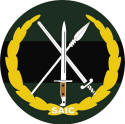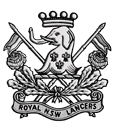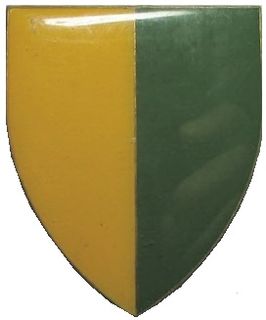
The South African Army Infantry Formation supervises all infantry within the South African Army.

Regiment President Steyn is an armoured regiment of the South African Army. As a reserve unit, it has a status roughly equivalent to that of a British Army Reserve or United States Army National Guard unit. The Regiment was named after Martinus Theunis Steyn, the last President of the Orange Free State Republic and is stationed in the city of Bloemfontein. It is part of the South African Army Armour Formation.

The South African Irish Regiment is an infantry regiment of the South African Army. As a reserve unit, it has a status roughly equivalent to that of a British Army Reserve or United States Army National Guard unit.

Regiment Westelike Provincie is a mechanised infantry regiment of the South African Army. As a reserve unit, it has a status roughly equivalent to that of a British Army Reserve or United States Army National Guard unit.

The Light Horse Regiment (LHR), formerly the Imperial Light Horse (ILH), is an armoured car reconnaissance unit of the South African Army. As a reserve unit, it has a status roughly equivalent to that of a British Army Reserve or United States Army National Guard unit. It is part of the South African Army Armour Formation and is based at Mount Collins in Sandton, Johannesburg.

The Umvoti Mounted Rifles is an armoured regiment of the South African Army. As a reserve unit, it has a status roughly equivalent to that of a British Army Reserve or United States Army National Guard unit. It is part of the South African Army Armour Formation and is based in the town of Pinetown.

Regiment Oranjerivier (ROR) is an armoured regiment of the South African Army. As a reserve unit, it has a status roughly equivalent to that of a British Army Reserve or United States Army National Guard unit. It is part of the South African Armoured Corps/South African Army Armoured Formation and is based in Cape Town.

Regiment Botha is an infantry regiment of the South African Army. As a reserve unit, it has a status roughly equivalent to that of a British Army Reserve or United States Army National Guard unit. The Regiment was named after General Louis Botha, the first prime minister of South Africa.
There are 13 Cavalry Regiments of the British Army each with its own unique cap badge, regimental traditions, and history. Of the currently 9 regular cavalry regiments; 2 serve as armoured regiments, 3 as armoured cavalry regiments, 3 as light cavalry and 1 as a mounted ceremonial regiment. There are also four yeomanry regiments of the Army Reserve, of these, 3 serve as light cavalry and 1 as an armoured regiment. Each yeomanry light cavalry unit has been paired with a regular unit of the same role, the armoured yeomanry unit is paired with the 2 regular armoured units. All except the Household Cavalry are part of the British Army's Royal Armoured Corps.
The Second Battle of El Alamein order of battle is a listing of the significant formations that were involved in the Second Battle of El Alamein during the Western Desert Campaign of the Second World War, 23 October – 4 November 1942.

The 1st Royal New South Wales Lancers was an Australian Army light cavalry (reconnaissance) regiment. Its complicated lineage includes the New South Wales Lancers which were first formed as a colonial unit in 1885 as the New South Wales Cavalry, and subsequently saw action in the Second Boer War, and later during First World War at Gallipoli and Palestine as the 1st Light Horse Regiment. The unit subsequently served during the Second World War as the 1st Armoured Regiment equipped with Matilda tanks, fighting the Japanese in New Guinea and Borneo.

The Italian invasion of Egypt was an offensive in the Second World War, against British, Commonwealth and Free French forces in Egypt. The invasion by the Italian 10th Army ended border skirmishing on the frontier and began the Western Desert Campaign (1940–1943) proper. The goal of the Italian forces in Libya was to seize the Suez Canal by advancing along the Egyptian coast. After numerous delays, the scope of the offensive was reduced to an advance as far as Sidi Barrani, with attacks on British forces in the area.

133rd Armoured Division Littorio or 133° Divisione Corazzata Littorio (Italian) was an armoured division of the Italian Army during World War II. The division was formed in 1939 from the Infantry Division Littorio that had taken part in the Spanish Civil War. It was a reserve unit during the invasion of France when it attacked through the Little St Bernard Pass, which was halted by the French defenders. It then took part in the Invasion of Yugoslavia, fighting at Mostar and Trebinje. It was sent to North Africa in the spring of 1942 where it fought until it was destroyed at the Second battle of El Alamein in November 1942.
The Battle of Piotrków Trybunalski was a battle in the Invasion of Poland from the 5 to 6 September 1939, which involved Polish and German tank formations.

7 South African Infantry Division was a formation of the South African Army, active from the 1960s to 1999.

8 South African Armoured Division was a formation of the South African Army, active from the 1970s to 1999.

Regiment Louw Wepener was an infantry battalion of the South African Army. As a reserve force unit, it had a status roughly equivalent to that of a British Army Reserve or United States Army National Guard unit.

Regiment de Wet was an infantry battalion of the South African Army. As a reserve force unit, it had a status roughly equivalent to that of a British Army Reserve or United States Army National Guard unit.





















